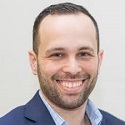

|
January 2019 |
[an error occurred while processing this directive] |
| |


EMAIL INTERVIEW – Therese Sullivan and Joe Pattenaude
Therese Sullivan, Tridium’s Customer Marketing Leader and Joe Pattenaude, Director of Building Systems at Bedrock
| Articles |
| Interviews |
| Releases |
| New Products |
| Reviews |
| [an error occurred while processing this directive] |
| Editorial |
| Events |
| Sponsors |
| Site Search |
| Newsletters |
| [an error occurred while processing this directive] |
| Archives |
| Past Issues |
| Home |
| Editors |
| eDucation |
| [an error occurred while processing this directive] |
| Training |
| Links |
| Software |
| Subscribe |
| [an error occurred while processing this directive] |
Sullivan: I’ve heard other Bedrock Real Estate leaders describe what is happening here, but it is another experience to come to downtown Detroit and see all the new construction and major renovations happening. From the new Shinola Hotel to all the big office towers going up, and the many small retailers and restaurants attracting street traffic, it feels buzzing and vibrant here. Detroit is not the stereotype of an abandoned rust-belt city anymore. What is the Bedrock formula?
Pattenaude:
As always, Detroit is an energetic place with geographic advantages for
growing a business. Young people that want an affordable urban
lifestyle are attracted here. Canada is just over the bridge, so people
have an international perspective. And, there is hockey! The cranes
everywhere are the most obvious signal of the massive change underway.
What you might not see at first glance is that we are creating an
experience for everyone that comes to Detroit. We are designing
operationally advanced facilities to help provide the feeling of
excitement; something businesses want to be a part of and a place you
might want to live.
Sullivan: What
do you do to ensure a building infrastructure that supports the
‘operationally advanced facilities’ that new Detroiters are starting to
expect?
Pattenaude: When
necessary, we renovate buildings from the inside out, starting with the
implementation of top-of-the-line technology infrastructure. Niagara
Framework provides the core of that. We also use Niagara to
integrate BMS data streaming with the Niagara Framework. This allows it
to combine with data from other equipment and devices so that we have a
centralized console to spin all this data into the valuable information
that we need to build better and manage our properties.
Sullivan: I noticed in the Bedrock Detroit Smart Building Specification that you spell out clearly in the Installing Contractor Scope section (Point #7) “Tag all points as per Haystack Tagging Conventions.” Then in the Master Integrator Scope section: “Verify all points have been integrated with all required points and tagged properly.” How is all that tagging and verifying working out for you?
Pattenaude: Any
contractor or integrator that works on a Bedrock project must tag what
they are doing. We specify Haystack tagging to get all the naming to
conform to one system. The biggest advantage of tagging is the ability
to bake in associations. This allows us to look at any piece of
equipment or device, an individual VAV, for example, and answer the
questions ‘What systems are serving data to this asset?’ and ‘To what
systems does this asset serve data?’
I
measure the value delivered by tagging – and any of our investments
into a better interface for building operational data – in terms of the
efficiency of my team. This ROI is so much bigger than energy saving
metrics. We are a core group of about seven controls & integration
engineers managing the OT networks for Bedrock properties across the
city. We don’t want our engineers to spend their time struggling with a
controls system interface or resorting to printing out time-series logs
and trying to interpret them manually. If we can make them more
efficient through naming and tagging, and a user interface and
analytics software that makes a point of the data obvious, we can make
their work much more efficient. We measure that improvement in terms of
reduced operational costs.
Overload. There are too many processes running under this userid. Please wait a minute and try again. (fork failed)
Sullivan: Do the financial managers at Bedrock agree that this is a good way to measure ROI?
Pattenaude: Yes,
they get it for the most part. If I get pushback, it is not about the
value of enforcing our Smart Building specification for new
construction or for a major controls retrofit; rather there might be
questions about the need to invest in the integration work to bring the
data from all our existing parking garages into our central building
data system. Consider that last week-end we had a time-change for
Daylight Savings Time. Those events can trigger a lot of calls about
scheduling problems with parking garage equipment. Getting garages
tagged and integrated is work that will pay for itself in two such time
changes.
Sullivan: You
mentioned that your team is overseeing OT networks in buildings. Where
do you stand on the question of running operational data over the same
IP network as the IT data that runs enterprises?
Pattenaude: One
of Bedrock’s first Detroit properties was One Campus Martius.
Understanding how to optimize an IT network for banking applications is
how Quicken Loans catapulted into its current position as the largest
retail lender in the US. I don’t want my operational data needs to be
at the mercy of a network designed for banking. OT and IT are
completely different applications. While every operational asset across
all properties will eventually be IP addressable, I need to be able to
optimize the network for OT data.
Sullivan: So just to sum up, where do you think you are on this OT journey?
Pattenaude: Over 2017 and 2018, my focus was on building a controls and data integration platform that would make my team more efficient in its role of managing our OT networks. My plan for 2019 is to focus on the rollout of this integration platform and OT data to the facilities teams at each property to make them more efficient. From there, I would like to open our OT data to tenants and retailers, which would ultimately lead to better business outcomes.
For more information on Haystack visit Project Haystack Update article.
[an error occurred while processing this directive]
[Click Banner To Learn More]
[Home Page] [The Automator] [About] [Subscribe ] [Contact Us]